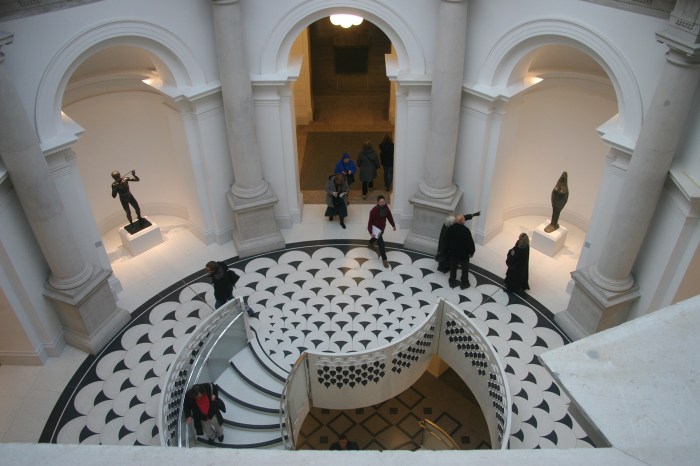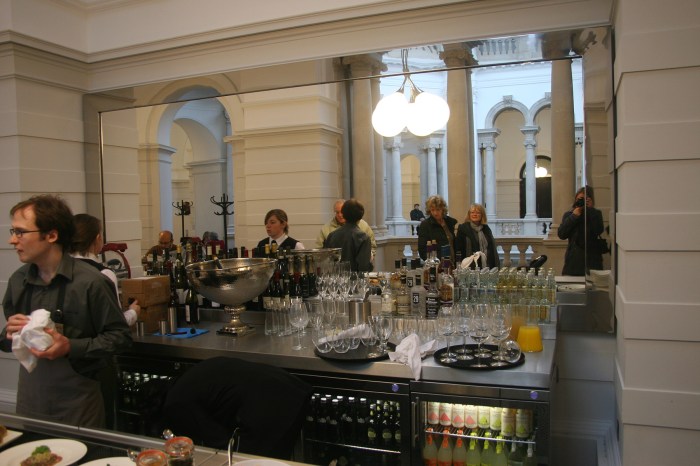Last week saw the opening of the newly refurbished Tate Britain, which was much acclaimed by art and architecture lovers alike. The Millbank riverside main entrance was re-opened and the central entrance space underneath the rotunda was transformed by Caruso St John Architects into a stunning three-storey space connecting the lower ground floor via a spiral staircase and allowing views across the floors. The result is a space bringing art and architecture together in a beautiful harmony.
However, the refurbishment is interesting because it is not only about aesthetics and beauty. It introduces a whole new visitor’s experience and therefore defines new ways of space usage in a museum. Let me elaborate a bit on this.
Tate Director Nicolas Serota called the New Tate Britain a “social space” and a “laboratory as well as a showcase for art“. He continues that the museum is supposed to be “a place in which people can have a provocative and enjoyable engagement with society, history and the present through art.”
This is interesting, since it assigns an active role to the visitor, but also implies that people may come to the museum not only to appreciate or consume art, but to interact with others, hence it becomes a social space. Now, this is certainly nothing new to researchers investigating museum spaces and visitor’s experiences. The social component has long been analysed by Space Syntax research, for instance by Choi, Hillier & Tzortzi or Kaynar-Rohloff. The basic argument is that the structure of the spatial layout of a museum shapes the paths of visitors (shown in the classic study of Tate Britain in 1995 by Space Syntax Ltd), but spatial configuration also shapes the way visitors engage with objects and artefacts, and the occurrence of encounters and social interactions in museums.
While this research reaches back almost two decades, the focus placed on the social experience in the New Tate Britain is new. It seems that consuming art is increasingly thought of as a shared experience involving communication and interaction, both in the physical and virtual worlds (for instance by lively user interactions on Twitter).
Another fascinating aspect of the way Tate Britain presents itself and aims to create new experiences for visitors becomes clear in a series of videos, in which Kevin McCloud discusses the history and reconstruction of Tate Britain (Part 1), the vision behind the transformation process (Part 2), and the new visitor’s experience (Part 3). In the third video, two quotes stand out specifically for me:
“One of the things that I particularly like is the fact that I can now come here and enjoy art, but I can also enjoy the architecture.” (Kevin McCloud)
“People will come now for the food and the drink, the good time, the socialising, for the free wi-fi, for the whole experience. And for a bit of art.” (Kevin McCloud)
Again, museums have long provided food and drinks, however, the focus placed on this in the New Tate Britain is refreshingly new. All food related facilities are now placed directly adjacent to the rotunda space – the main cafe and the restaurant on the lower ground floor, and the Tate Members Room serving coffee, cakes, but also lunch and wine is located on the first floor looking up towards the rotunda and looking down towards the spiral staircase. All of these spaces are lovingly designed, most of all the stunning Members Room (which used to be small and hidden away in an almost inaccessible place).
It seems that Tate Britain aims to be more than ‘just’ a museum, where people go to in order to see pieces of art. It aspires to be a place for architecture lovers, for foodies, for coffee connoisseurs, for families, for business meetings, for music and performance fans, and for party-goers as the following tweet shows:
Party in the duveens! Alexis Taylor from @Hot_Chip is rocking our house warming party! #TateBritain pic.twitter.com/A4X3SLelOm
— Tate (@Tate) November 23, 2013
So is the Tate defining a new building type with its Tate Britain? A building that serves multiple purposes, invites a diversity of usages and is open to different communities while at the same time offering well-designed spaces and a generally good time for everyone going there? Again, I would argue that these types of buildings have existed in one shape or another for a while now and certainly other public buildings such as the Royal Festival Hall or the British Library could be argued to do exactly that – provide space for public usage and appropriation. Still it is wonderful to have another one of those buildings on offer in London that invite people to come and do whatever they want to do.




